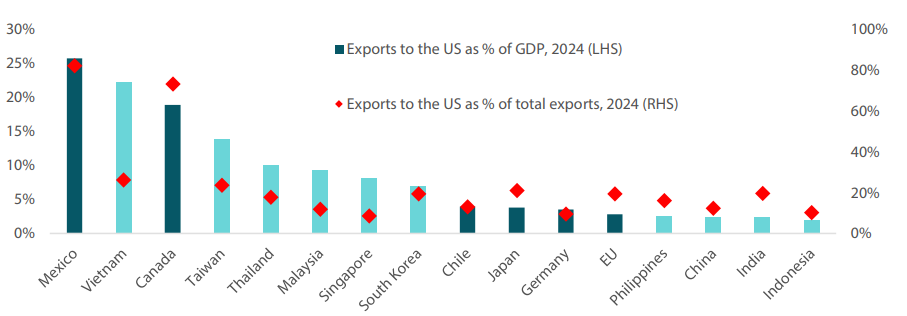The "Liberation Day" US tariffs are expected to strongly impact Asia, where most countries run a trade surplus with the US. Although significant uncertainty is likely to linger, our base case is for most of the region's economies to negotiate with the US and thus mitigate much of the impact from the initial announcement. Regarding Asian local government bonds, we retain a positive outlook for several countries that have the capacity to pre-emptively implement monetary and fiscal policy responses. Most Asian corporates and banks also entered 2025 with strong balance sheets and rating buffers, which could cushion them during this period of high volatility.
On 2 April, US President Donald Trump announced "Liberation Day" tariffs which were significantly higher than what we and the market expected. The impact of these tariffs was especially pronounced in Asia, where most countries in the region run a trade surplus with the US. Many ASEAN countries and China were particularly affected, facing reciprocal tariffs exceeding 30%.
The announcement rattled markets, which are now closely watching how the region responds to Trump's tariff offensive. Excluding China, most governments have signalled they are unlikely to retaliate. Instead, they appear focused on engaging with the US in negotiations, hoping to secure reduced tariff rates, although the outcome of these negotiations remains highly uncertain. Nonetheless, the newly imposed tariffs are expected to weigh on regional growth. Initial attention will be on which economies face the largest tariff increases, how export-driven these economies are, and whether they can successfully negotiate lower tariffs.
To better understand the potential impact, we have also calculated the percentage of exports to the US as a gauge of the tariff effects.

Source: IMF, Bloomberg, Nikko AM
In Asia, the indirect effects of tariffs will likely be the dominant channel through which the growth drag will manifest. Overall, we expect Asian policymakers to have sufficient monetary and fiscal tools at their disposal to mitigate the impact from slower growth as inflation has eased, providing central banks with room to cut rates. Improved fiscal positions over recent years will also allow governments to implement stimulus measures to support growth.
Within Asia, China and Vietnam are likely to be impacted the most, while the Philippines and India are likely to be more insulated as domestic demand comprises about 70% of their GDP. China has responded with a 34% tariff on all US imports, raising the risk of further escalation in trade tensions. Meanwhile, Vietnam, which is highly reliant on its exports to the US, which contribute over 20% of its GDP, was hit with a 46% tariff. Vietnam has already offered to remove all tariffs on US imports, but it remains to be seen how Washington might respond.
China
With its own announcement of a 34% retaliatory tariff equalling the US reciprocal tariff, China has now shifted from its measured responses to a more confrontational one. If the proposed tariffs
hold, there would be significant impact to China's economy. But China is likely to embark on some countermeasures. First, it could allow currency depreciation to a limited extent to partially
cushion the tariff impact. Next, it could continue to diversify its exports to non-US markets. Besides the external front, China is also likely to front load fiscal stimulus and further enhance
its accommodative monetary policy stance by cutting policy rates and bank required reserve ratios. Should it be required, China had indicated that it has further room to increase its fiscal
deficit, and we think this could happen in the second half of the year. Though it looks less likely in the near term, we think there is still a chance that the US and China could come together and
negotiate their differences spanning trade, security and other areas.
India
For India, the significantly higher tariff rates imposed on countries like Vietnam, Myanmar, and Laos could present an opportunity, as companies look to re-route exports through India to the US.
Notably, Apple is reportedly planning to increase iPhone shipments to the US from India to offset the higher tariffs on Chinese-made devices. India has stated that it does not intend to retaliate
against the new tariffs and is instead exploring a provision in Trump's order that could offer reprieve to countries that "take significant steps to remedy non-reciprocal trade arrangements".
India sees an advantage in being one of the first nations to initiate trade talks with the US, with both countries committing in February to finalise an early deal by Autumn 2025. To strengthen
ties, India's Modi administration has already made goodwill gestures, such as lowering tariffs on premium motorcycles and bourbon and eliminating a digital services tax that had affected major US
tech firms.
Philippines
The US imposed lower tariffs on Philippine exports compared to its Asian counterparts, and the economy's reliance on domestic demand rather than exports provides additional resilience.
Furthermore, the government views the new tariffs as a "window of opportunity" for the Philippines to increase its share of the US market, particularly for exports such as garments and
coconut-based products, which are now more competitive due to lower tariffs compared to countries like China and Thailand. Nevertheless, the government has expressed its intention to proactively
engage with the US in hopes of securing a reduction in the US tariff rate.
Asian credit sectors
By sector, we expect technology hardware issuers and industrial companies with sizeable revenue exposure from the US to be directly affected. These sectors represent approximately 5% of Asia
credit. However, the repercussions are likely to cascade across all sectors, with the heightened risk of a global recession depending on how long the trade conflict lasts. Banks' profitability is
likely to be impacted by lower interest rates and higher credit costs, while commodity-related credits will suffer from lower commodity prices.
Market reaction so far
The market has so far responded with a classic risk off move. Bond yields have fallen, credit spreads have widened and equity markets have slumped. As of 7 April, the JACI Investment Grade index has retreated by 0.04% month-to-date, outperforming the US Investment Grade index, which has retreated 1.51% (iBoxx USD Liquid Investment Grade Total Return Index). This outperformance can be attributed to the widening in credit spreads being offset by gains in US Treasuries. Meanwhile, as of 7 April the JACI Non-Investment Grade Corporates index has dropped 3.50% month-to-date, compared to the 2.65% decline by the US High Yield Corporates index (Bloomberg US Corporate High Yield Total Return Index).
Over the same period, local currency government bonds have rallied, in line with movements in US Treasuries. On a total return basis, Chinese, Singapore and South Korean government bonds have outperformed, while Philippine and Indonesian government bonds have underperformed. In the FX market, most Asian currencies have come under pressure this month amid broad-based US dollar strength. The Thai baht and Indonesian rupiah posted the steepest declines, falling 2.07% and 1.44% respectively, while the South Korean won bucked the trend, eking out modest gains of 0.20% against the greenback.
Outlook
Since the tariff announcement, the Asia Fixed Income team has viewed US duration with caution and favoured duration-neutral curve steepeners amid rising stagflation risks in the US. On the Asia local rates front, we retain a positive outlook for several countries that have more policy space to pre-emptively implement monetary and fiscal policy response to absorb any economic drags and disinflationary impacts. Meanwhile, we are closely monitoring conditions in the markets. We are particularly focused on those with shallower market depth in the event global outflows accelerate or if market functioning becomes impaired. We are poised to pare risk if liquidity conditions deteriorate. On the credit side, we are taking a sector-focused approach. We have been trimming exposure to cyclical and trade-related sectors, rotating into non-discretionary and defensive sectors. We are also conducting portfolio reviews to identify and manage idiosyncratic risks, particularly regarding names that may be vulnerable to business cycle pressures, cash flow disruptions or debt rollover risk.
Going forward, our base case is for most economies to negotiate with the US to lower tariffs and thus mitigate much of the impact from the initial announcement. However, significant uncertainty is likely to linger, along with the risk of increased tit-for-tat measures in the near term. Most Asian economies entered this period of higher volatility with relatively robust external, fiscal and domestic demand conditions, which could partially offset tariff-related uncertainties and provide a good buffer against challenges ahead. Notably, China's policymakers have reportedly already begun discussing stimulus measures. In addition, most regional central banks retain some room to ease monetary policy to support domestic demand, with inflation having declined (giving central banks room to cut rates) in the region. Most Asian corporates and banks also entered 2025 with strong balance sheets and rating buffers, which could help cushion the impact.
We see the recent widening of credit spreads as a healthy development, as it creates more attractive entry points. We also expect favourable demand-supply technicals to support the medium-to-long-term performance of Asian credits. Gross and net supply in Asia credit is still expected to remain benign throughout 2025.
On rates, we maintain that Asia's local government bonds are well-positioned for decent performance, supported by accommodative central banks in an environment of benign inflation and moderating growth. Concerns over potential growth shocks from US tariffs are likely to provide additional support for regional bond markets. Additionally, with relatively high FX reserves, policymakers are well-equipped to defend their currencies if necessary.




